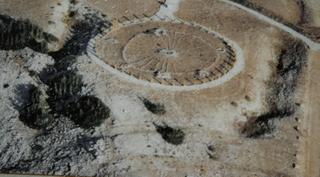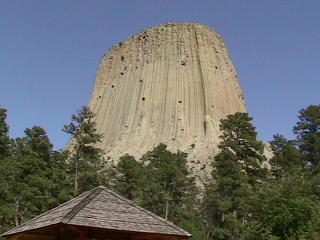Photograph by Clifford Johnson
While on Cosmic Invariance, Clifford brings a much needed attempt at explanation on how we view the landscape. I'll have to spend sometime going over this becuase it is a critical position and difference between two facets of thinking within the scientific community. Susskind and Lee Smolin have lead this discussion repeatedly before, and I find this continued effort, a nice way to continue to peer into.
Some response helps too, and indicates our attention to the reasons why such positions are adopted. I find this very important in understanding why these respective positions, are taken and what possibly might issue from the stated position.
Lee Smolin on Aug 15th, 2005 at 9:01 am :
Method A: ASSUME 1) that there is a real non-perturbative theory behind all the approximate calculations and 2) that it is relevant for nature. Then interpret various results, having to do with dualities, the landscape etc given these assumptions.
Method B: Look for evidence that the two assumptions of method A are true.
One evaluates results very differently, depending on whether one uses method A or method B. There is nothing wrong with using Method A from time to time, so long as the assumptions are made explicit, and the risks that are thereby taken on explicitly acknowledged. One can learn things that will turn out be true about the theory, if 1) is true, or about nature, if 2) is true. But one cannot do science only or even mostly by Method A, no matter how promising an idea may seem. What I find disturbing in your essay, and in many conversations with string theorists is that they reason by Method A but they do not state explicitly their assumptions. This puts me often in the uncomfortable situation, when discussing with a string theorist, of having to add, “but there is one more possibility, the theory might be wrong.”
So Jacque Distler adds his views and I heard he walked out on the conference? So am I to take it that this very topic tries his impatience, that he might have seen bias raise it's ugly head, or that holding a position like Peter Woit's put them the odd man out? I think Lee is doing a fine Job of trying to keep cohesion amongst the scientists that we do not have to worry, about such antics, as they eventually come around to accept the debate?:)
Jacques Distler on Aug 15th, 2005 at 10:52 am
Lee was, most recently, at Strings 2005, and he does hang out with his stringy colleagues at Perimeter.
I don’t know whether that counts for you, but it does for me.
The Layman's view
As stated before in how Clifford presents his perspective I immediately noticed a corresponding image in my mind in terms of hypherysics.
Now you have to forgive my laymen perspective because when they start talking about the landscape, I tend to see this completed image in my mind, much as I have relayed it here(Are Scientists Currently Censoring Debate on Global Warming). Although it seeks to detail the environment as a relative view on such perspective as landscape, I thought I would see how Cliiford's view and the resulting talks might have been understood from my own perspective.
Unfortunately I do not have the guidance other then what I can intuitive garner in my continue development, so I hope I do other justice and do not degrade this topic in any way.
The ground state of a three-dimensional box of dimension L can be obtained by setting n=1 for all three dimensions, giving an energy three times the ground state energy of the one-dimensional box. The ground state for the three-dimensional box would be
So when one looks at these images of the landscape what is being said here, I tried to garner a overall perspective as I did in the "censoring debate on Global warming".
I give a direct link to the picture that had been presented early on in my research, because I tended to see this split very early on as a positional one worth taking note. But somewhere along the line my thinking changed as I saw the vast differences and capabilities of the bulk possibilities in terms of graviton scattering and condensing feature.
So transferring this thinking to global differences help me to continue to see how Clifford or string theory approach to landscape development might be seen. I rest easy that there are those better qualified, but this has not limited what I have now been able to see. As others will see in the landscape interpretation.




